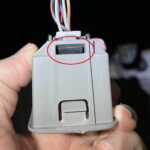Encountering difficulties connecting to the OBD2 port on your 2000 Dodge Dakota during a vehicle inspection can be a significant hurdle. Many vehicle owners face this issue, and it’s often related to simple fixes rather than major component failures. This guide provides expert insights into diagnosing and resolving OBD2 connector problems specific to the 2000 Dodge Dakota, ensuring your truck is ready for its emissions test and keeping you informed about potential issues.
Understanding the OBD2 System in Your 2000 Dodge Dakota
The On-Board Diagnostics II (OBD2) system is a standardized system in vehicles since 1996, including your 2000 Dodge Dakota, designed to monitor various vehicle systems, particularly emissions controls. The OBD2 connector, typically located under the dashboard on the driver’s side, is the interface point for diagnostic tools to communicate with your truck’s computer system, often referred to as the Powertrain Control Module (PCM). This connection is crucial for emissions testing, as inspection stations need to read data from your PCM to ensure your vehicle meets environmental standards.
Common Reasons for OBD2 Connection Failure in a 2000 Dodge Dakota
If your 2000 Dodge Dakota is failing an inspection due to OBD2 connection issues, several potential causes should be investigated before considering more drastic measures like replacing the PCM or wiring harness. Here are common areas to examine:
1. Fuses and Electrical Issues
The simplest and often overlooked cause is a blown fuse. The OBD2 port is powered by a fuse, and if this fuse is blown, the port will not function. Refer to your 2000 Dodge Dakota owner’s manual to locate the fuse specifically for the diagnostic port or PCM and check its condition. Replace any blown fuses with the correct amperage rating. Beyond fuses, check for any signs of corrosion or damage to the OBD2 connector itself and the surrounding wiring.
2. Battery Problems and PCM Reset
A dead or disconnected battery can sometimes cause the PCM to lose its memory, including the readiness monitors status. If your 2000 Dodge Dakota has recently had a battery issue, or if the battery was disconnected for an extended period, this could be contributing to the OBD2 connection problem and “not ready” status during inspection. Ensure your battery is fully charged and in good condition.
3. Readiness Monitors and Drive Cycles
Even if the OBD2 port is functional, your 2000 Dodge Dakota might fail inspection if the PCM’s “readiness monitors” are not set. Readiness monitors are internal checks that the PCM performs on emissions control systems. After a battery disconnection or PCM reset, these monitors often reset to a “not ready” state. To set them to “ready,” the vehicle needs to complete a specific “drive cycle.”
What are Readiness Monitors?
Readiness monitors confirm that your vehicle’s emissions control components have been thoroughly evaluated. If these monitors are “not ready,” it means the system hasn’t completed its self-tests since the last reset. For 1996-2000 vehicles, including your 2000 Dodge Dakota, having three or more unset monitors will result in an inspection failure.
Performing a Drive Cycle:
A drive cycle is a specific sequence of driving conditions designed to allow the PCM to run all necessary diagnostic checks and set the readiness monitors to “ready.” While Chrysler might have a specific drive cycle for the 2000 Dodge Dakota, a generic OBD2 drive cycle often works. Here’s a commonly used generic drive cycle:
- Cold Start: Ensure the vehicle has been sitting for several hours (ideally overnight) so the engine is completely cold.
- Idle: Start the engine and let it idle for 2-3 minutes without touching the accelerator.
- Moderate Acceleration and Cruising: Drive at a moderate speed (around 45-55 mph) for about 10-15 minutes, maintaining a steady throttle. Avoid sudden acceleration or braking.
- Deceleration and Idle: Safely decelerate and come to a stop. Idle for another 2-3 minutes.
- Repeat if Necessary: It may be necessary to repeat this drive cycle multiple times over a few days to set all monitors to “ready.”
You can use a personal OBD2 scanner to check the readiness monitor status yourself before going for an inspection.
Troubleshooting Steps Before Replacing the PCM or Wiring Harness
Before investing in a new PCM or wiring harness, which are more expensive solutions, consider these troubleshooting steps for your 2000 Dodge Dakota Obd2 Connector issue:
- Check Fuses: Inspect and replace any blown fuses related to the OBD2 port and PCM.
- Battery Condition: Ensure your battery is healthy and fully charged.
- Inspect OBD2 Connector: Look for any physical damage, corrosion, or loose wires at the OBD2 port.
- Perform a Drive Cycle: Follow a generic or Dodge-specific drive cycle to attempt to set the readiness monitors.
- Professional Scan: If you have access to a more advanced scan tool or consult a trusted mechanic, they can check for fault codes, PCM communication, and perform more in-depth diagnostics.
When to Consider PCM or Wiring Harness Replacement:
If you have systematically checked all the above points and are still facing OBD2 connection problems, then a faulty PCM or wiring harness may be the issue. However, these are less frequent causes. Consulting with a qualified mechanic specializing in Dodge vehicles is advisable before making these replacements. They can perform thorough electrical testing to pinpoint the exact cause of the OBD2 communication failure.
By following these steps, you can effectively troubleshoot OBD2 connector issues on your 2000 Dodge Dakota and increase the chances of passing your emissions inspection without unnecessary expensive repairs.
